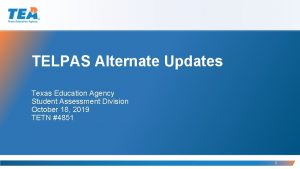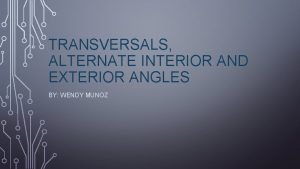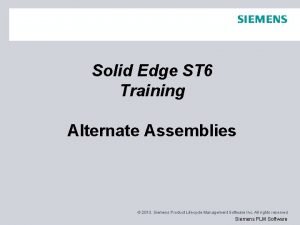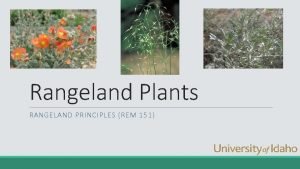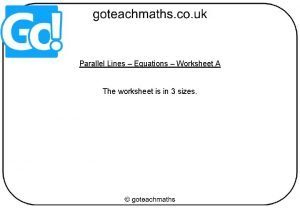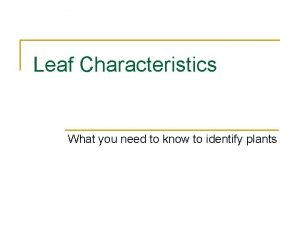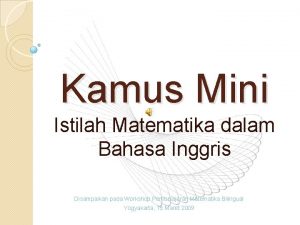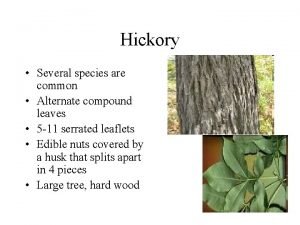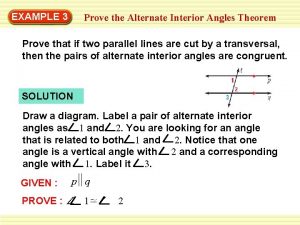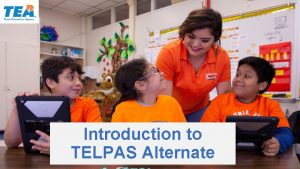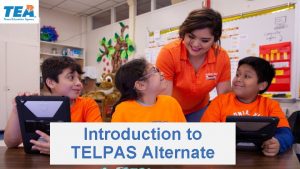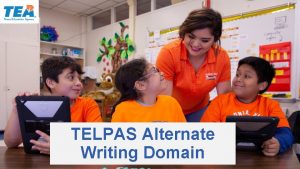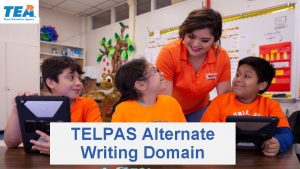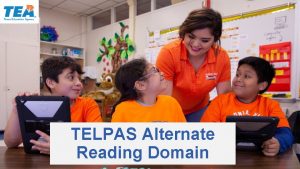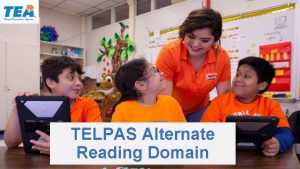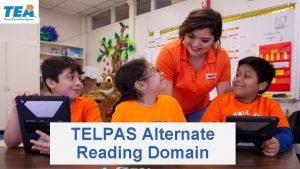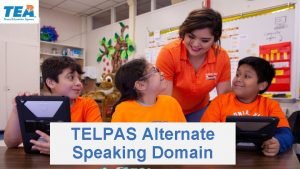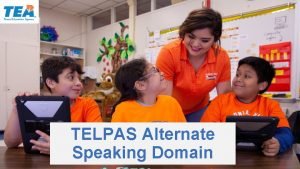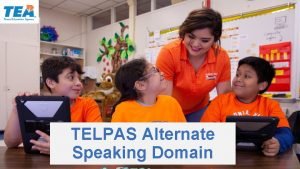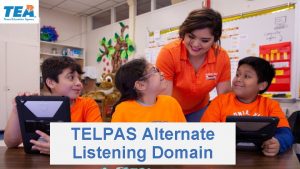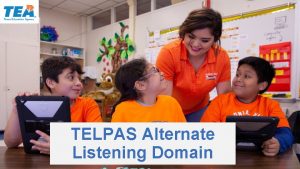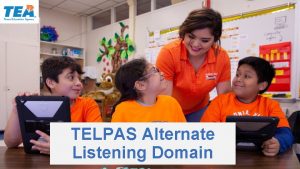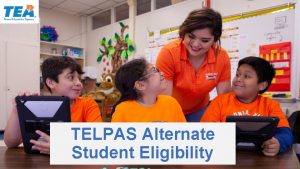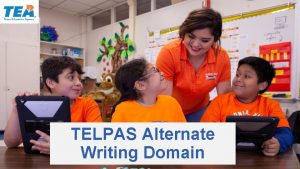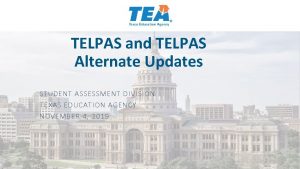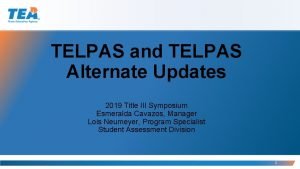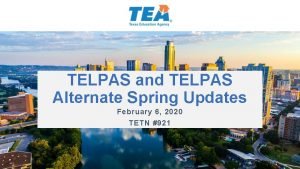Introduction to TELPAS Alternate Purpose of this TELPAS




















- Slides: 20

Introduction to TELPAS Alternate

Purpose of this TELPAS Alternate Training • Intended for any individual who needs a general overview of TELPAS Alternate § § Can be used as one of several training Power. Points for test coordinators and test administrators Can be shown to administrators or parents who need to have a basic understanding of TELPAS Alternate • Describes the new TELPAS Alternate assessment and the reason for its development • Provides a definition of the students in this special population • Outlines a schedule of events and additional training resources Student Assessment Division 2

TELPAS Alternate • The Every Student Succeeds Act (ESSA), requires each state to administer an alternate English language proficiency (ELP) assessment for English learners (ELs) with the most significant cognitive disabilities who cannot participate in the general ELP assessment, even with allowable accommodations. • The Texas Education Agency (TEA) worked with stakeholders to develop the TELPAS Alternate to evaluate grades 2 -12 students receiving special education services identified in the Public Education Information Management System (PEIMS) as limited English proficient (LEP) and also identified with a significant cognitive disability. Student Assessment Division 3

What is TELPAS Alternate? • A holistic inventory that assesses the language domains of listening, speaking, reading, and writing for students with significant cognitive disabilities in grades 2 -12 • Aligned to the Texas English Language Proficiency Standards (ELPS) • Based on alternate Proficiency Level Descriptors (PLDs) created to address the specific access needs of this population Student Assessment Division 4

Observable Behaviors The “test questions” in TELPAS Alternate are called observable behaviors. They are descriptions of student behaviors in the language domains of listening, speaking, reading, and writing. Test administrators consider how well students understand use English in a variety of social and academic situations. Student Assessment Division 5

Who takes TELPAS Alternate? Students taking TELPAS Alternate are English learners* in grades 2 -12 who have significant cognitive disabilities and who are in the process of acquiring English proficiency in listening, speaking, reading, and writing. These students have one or more disabilities that significantly limit their intellectual functioning, as shown by their ability to plan, comprehend, and reason, and their adaptive behavior, as shown by their ability to apply social and practical skills. *ELs whose parents have declined bilingual or English as a Second Language (ESL) program services are required to be assessed with either TELPAS or TELPAS Alternate. Student Assessment Division 6

Alternate Response Modes • For TELPAS Alternate, "English" is more inclusive to allow for all modes of communication in English. • Some English learners use sign language, braille, or another method of communication as a substitute for traditional English in one or more language domains. • Teachers should take into account whether an alternate response mode is an appropriate way for an individual student to demonstrate English proficiency in a specific language domain. Student Assessment Division 7

TELPAS Alternate Proficiency Level Labels • For each language domain, TELPAS Alternate measures five levels, or stages, of increasing English language proficiency versus the four levels in TELPAS (the general English language proficiency assessment). • Some TELPAS Alternate proficiency levels overlap some of the TELPAS proficiency levels. • By stretching out the Beginning and Intermediate levels of TELPAS, TELPAS Alternate provides more granular information about English language proficiency for students with significant cognitive disabilities. This can help educators more specifically assess growth and target instruction from year to year. Student Assessment Division 8

TELPAS Alternate Proficiency Level Global Definitions • Global definitions provide a common definition of the characteristics specific to each proficiency level across all four language domains and explain what it means for a student to be classified as: Awareness, Imitation, Early Independence, Developing Independence, or Basic Fluency. • Understanding the global definitions and features provides the foundation for understanding the language acquisition skills students possess at each proficiency level. Student Assessment Division 9

TELPAS Alternate Proficiency Level Labels and Global Definitions Proficiency Level Label Global Definition Awareness Students who receive this rating may be aware of English sounds or print; however, they have little or no functional ability to participate in communication activities in English. Imitation Students who receive this rating match, imitate, or approximate some English in their environment; however, they are not able to independently understand or produce English. They participate in routine communication activities in a familiar environment when the activities are significantly linguistically accommodated. Early Independence Students who receive this rating understand short, simple messages and produce messages of one or two high-need, high-frequency words (e. g. , book, cafeteria, teacher). They are starting to participate in linguistically accommodated communication activities in English in familiar environments. Developing Independence Students who receive this rating understand longer messages of multiple sentences in English and produce simple, descriptive, original messages by combining two or more words (e. g. , new red bike, big fast truck). They participate meaningfully in linguistically accommodated communication activities in English in familiar environments. Basic Fluency Students who receive this rating understand produce more detailed, complex, and elaborate messages with multiple sentences in English. These students participate independently in communication activities in English in familiar environments. Student Assessment Division 10

Alternate Proficiency Level Descriptors • While the global definitions from the previous slide apply across all four language domains, the alternate PLDs present the major characteristics of students who are classified at the Awareness, Imitation, Early Independence, Developing Independence, or Basic Fluency proficiency level for reading, writing, speaking, and listening. • The PLDs are domain-specific and define how well ELs at the five proficiency levels are able to understand use English in social and academic settings. • The descriptors show the progression of second language acquisition from one proficiency level to the next and serve as a road map to help teachers tailor instruction to the linguistic needs of ELs. • They provide a common framework for understanding the language acquisition skills needed to be classified within each proficiency level. Student Assessment Division 11

TELPAS Alternate Test Blueprint Development • TELPAS organizes the majority of the ELPS student expectations under several reporting categories, or skill areas, on the test blueprints. • In order to create the TELPAS Alternate test blueprints, educators from around the state reviewed the ELPS student expectations and determined those most accessible and assessable for ELs with significant cognitive disabilities. • These student expectations were then organized under the same reporting categories as TELPAS; however, the blueprints are not identical. § § • TELPAS contains more test questions than TELPAS Alternate. Some student expectations were deemed not accessible and therefore not assessable for students with significant cognitive disabilities. TELPAS Alternate test blueprints illustrate the number of observable behaviors assessed in each reporting category with a total test length of 10 observable behaviors per domain. Student Assessment Division 12

TELPAS Alternate Test Blueprints Student Assessment Division 13

Process for Considering Reclassification of English Learners with Special Needs For questions regarding reclassification: § Bilingual and English as a Second Language Education Programs webpage § Division of English Learner Support: 512 -463 -9414 § English. Learner. Support@tea. texas. gov Student Assessment Division 14

Schedule of Events Districts receive TELPAS Alternate manuals and materials January 6– 10, 2020 TELPAS Alternate materials posted and TETN presentations October 2019 TELPAS Alternate webinar Preliminary TELPAS Alternate reports posted January 28, 2020 May 8, 2020 Required TELPAS Alternate training sessions TELPAS Alternate administration window January–February 2020 February 24–April 3, 2020 Student Assessment Division Final TELPAS Alternate reports posted May 22, 2020 15

TELPAS Alternate Training Resources Resource Purpose Audience Educator Guide to Provides an overview of TELPAS and TELPAS Alternate and serves to TELPAS and TELPAS support effective implementation of the ELPS Alternate Administrators, Coordinators, Teachers Participation Requirements Used by ARD committees in conjunction with the LPAC to make decisions about TELPAS Alternate Members of ARD committees and LPACs Observable Behaviors Measures the student’s use of English and contain a notes section that can be used to become accustomed to TELPAS Alternate prior to the assessment window Teachers TELPAS Alternate Resources webpage: https: //tea. texas. gov/Student_Testing_and_Accountability/Testing/Texas_English_Language_Proficiency_Assessment_System_(TELPAS)/TELPAS_Alternate/ Student Assessment Division 16

TELPAS Alternate Training Resources (continued) Resource Purpose Audience Parent Brochure Communicates to parents basic information about TELPAS Alternate Parents Test Administration Manual Contains instructions covering the responsibilities of test administrators and the observable behaviors used to assess students Administrators, Coordinators, Teachers serving as test administrators Training Power. Points (See list on next slide) Provides training on a variety of topics, including authentic classroom activities for each domain that explain how to rate students with the observable behaviors Required to be read carefully and followed as written Designed as short Power. Points that can be viewed in 30 minutes or less Administrators, Coordinators, Teachers serving as test administrators Are optional though highly recommended TELPAS Alternate Resources webpage: https: //tea. texas. gov/Student_Testing_and_Accountability/Testing/Texas_English_Language_Proficiency_Assessment_System_(TELPAS)/TELPAS_Alternate/ Student Assessment Division 17

Available TELPAS Alternate Training Power. Points q Introduction to TELPAS Alternate q Student Eligibility q Speaking Domain q Listening Domain q Reading Domain q Writing Domain q Accessibility q Test Administration Student Assessment Division 18

Contact Information TEA’s Student Assessment Division 512 -463 -9536 assessment. specialpopulations@tea. texas. gov Pearson’s Customer Service Center 800 -627 -0225 Tx. Pearson. Access@support. pearson. com Student Assessment Division 19

Disclaimer These slides have been prepared by the Student Assessment Division of the Texas Education Agency. You are encouraged to use them for local training. If any of the slides are changed for local use, please hide or remove any TEA logos, headers, or footers. (You may need to edit the Master slide. ) In addition, you must remove the photographs. Only TEA has parental permission to use these photographs for training purposes. This training is not intended to replace any materials or additional information on the TEA website. Student Assessment Division 20
 Telpas alt resources
Telpas alt resources Sentence purpose
Sentence purpose General purpose specific purpose central idea
General purpose specific purpose central idea Alternate form of reliability
Alternate form of reliability Alternate exterior angles in real life
Alternate exterior angles in real life Angle in alternate segment
Angle in alternate segment Solid edge alternate assemblies
Solid edge alternate assemblies Common curly mesquite
Common curly mesquite Poesia con onomatopee
Poesia con onomatopee Basic vfr minimums
Basic vfr minimums Parallel lines and transversals worksheet
Parallel lines and transversals worksheet Alternate exterior angles
Alternate exterior angles Coniferous leaves characteristics
Coniferous leaves characteristics Scalloped leaf margin
Scalloped leaf margin Rime alternate
Rime alternate Esempi di allitterazione
Esempi di allitterazione Kamus matematika bahasa inggris
Kamus matematika bahasa inggris Vfr flight plan
Vfr flight plan Alternate vs opposite leaves
Alternate vs opposite leaves Pacer test
Pacer test Alternate interior angles theorem proof
Alternate interior angles theorem proof
